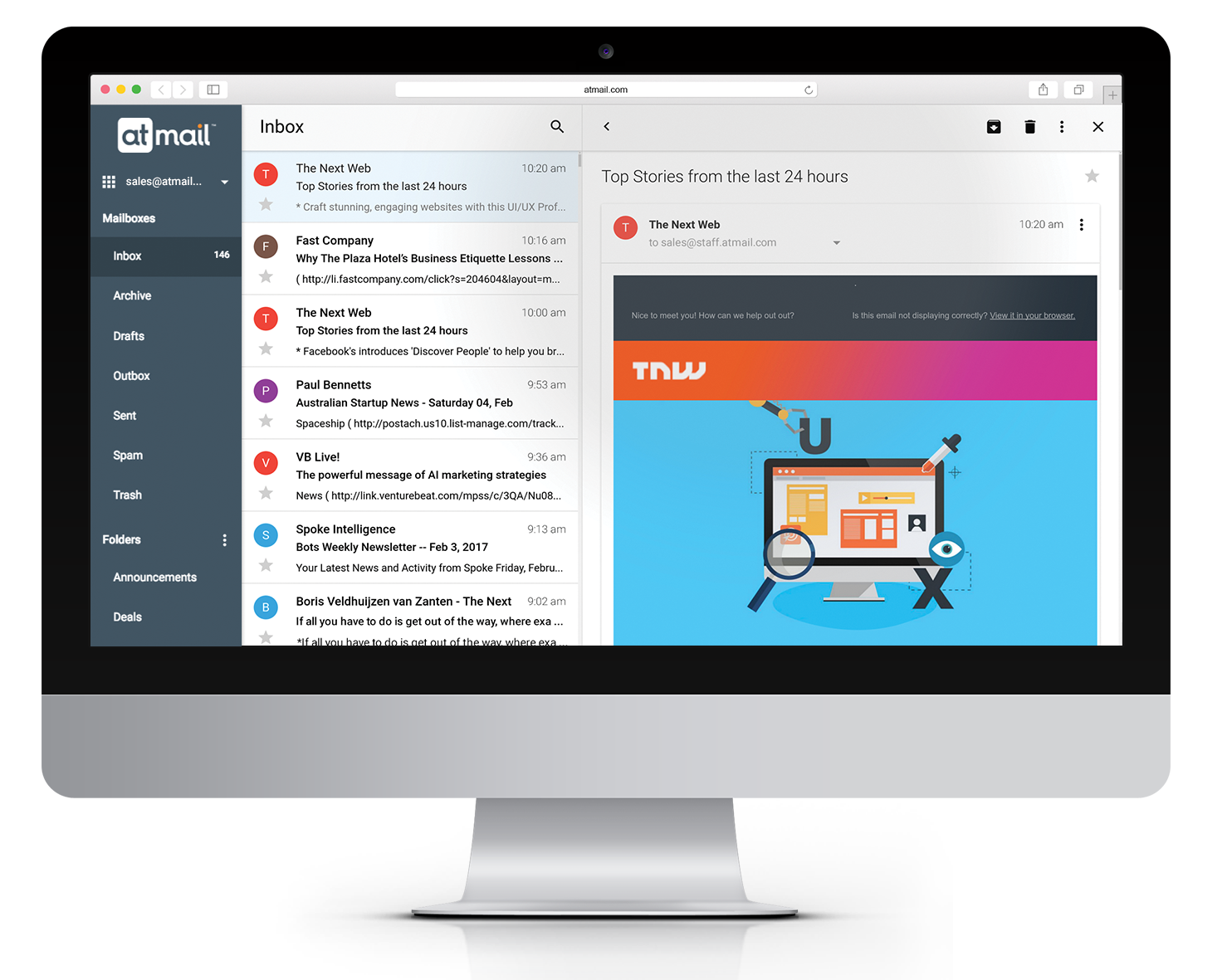
atmail: 20 Years and Counting: Interview with Ben Duncan
atmail‘s origin story, like many tech startups, begins with one person and a laptop. Writing code late into the night, uploading software as you can, when the network is good. While these things may be commonplace today, they were not so mainstream or glorified when atmail’s founder Ben Duncan set off in his Land Rover to circumnavigate the Australian continent and commit to atmail as a full time project.
With atmail celebrating our 20 year anniversary this year as a trusted email solutions provider to telcos and service providers, we sat down with Ben (who has stepped aside from atmail’s day-to-day but still serves as a board member) to talk about the last twenty years, as well as what the future of messaging (and atmail) might look like.
Audio interview with Ben Duncan, atmail’s founder

Ben Duncan is interviewed by Jason Brown, atmail’s Global Solutions Architect
Transcript of Ben Duncan’s interview
atmail: So, why the name atmail?
Ben: Alright, so, originally I think when we first kind of launched atmail, back in ’98, there was a website, I think it was cgiresources.com or the like. It was a collection of CGI scripts, Perl scripts and it was alphabetical and I decided to name it atmail because it appeared at the top of their ranking. When you would go to the category of email, atmail was at the top. So, that’s kind of how it was born, with the “@” symbol.
atmail: Alright, we’re here talking today talking with Ben Duncan, founder of atmail. We’re talking today about the 20th anniversary of the company. Ben, how are you today?
Ben: Yeah, really well thanks, greetings from the Sunny Coast, Australia.
atmail: So, you started the company in 1998. Why? I mean, why the choice to start an email company and was that your choice?
Ben: So, at the time, I left home when I was about 16 and partnered up with one of my business friends to launch a web hosting company. This was back in the early days of ’97, when virtual hosting was kind of hot off of the press and virtual servers and the chroot environments for running instances and good ol’ FreeBSD. So, I was kind of the CTO, technical guy kind of go-to guy for the startup. atmail was kind of born out of solving our own problems. I had the task of building a mail platform for our customers that they could white label and create their users’ email accounts and generate some revenue off selling email hosting and the like. So, while building this email module for the startup we were in, I quickly realised that yeah, this is quite a neat product here and there’s quite a lot of demand. So, this was before the days when Hotmail was big and Yahoo was just kind of getting started. So, it was a lot of greenfield kind of email, a lot of people coming on. And after quickly launching atmail (the first version), there was like an incredible demand online and I started receiving like a lot of orders and sales enquiries and a lot of buzz. And to me that was the moment where I kind of jettisoned the web hosting startup I was with and started focussing on atmail full time. And by that time I think I was about 17 or 18 and it was a lot more difficult to get a merchant account back in those days. So, for the first six months, I actually couldn’t charge users – didn’t have the merchant account facility. So, basically we had a lot of pre-orders and customers using the software and committed to payment and once we had all our banking and merchant accounts finalised, kind of, you know, ran six months of orders through for the customers using it and it kind of grew from there.

atmail: Excellent. So, would you say that that was, I mean, so email like then, email was kind of a, you know, a niche market. I mean it wasn’t what it is today?
Ben: Yeah, I think back then, it kind of reminds me, how do I say? Like, ’97-’98 for me it was kind of like the boom era of the Internet. There was like a lot of new vendors coming on the scene. There wasn’t a lot of consolidation and a lot of greenfield. So, yeah, we were lucky enough to kind of launch way back then and kind of start attracting customers and our brand and we have customers who’ve been with us for 15 years, from those early days and yes somewhat now, industries consolidated massively. There’s a lot fewer players in our space that atmail plays but we’ve been here for nearly 20 years now. Kind of one of the foundational email companies out there for hosting providers and ISPs.
atmail: Email is now part of the fabric of the industry.
Ben: Yeah and I think until there is like another protocol which is open such as SMTP, IMAP, I think it’s going to be hard to disrupt email. It’s like the backbone for communication. So, whilst there’s you know a lot of new players such as Slack for messaging and a lot of people are moving to other services. These are all kind of walled gardens and you know one vendor rules the roost. So, it’s my firm belief that until there’s a protocol which is open, email will remain quite a foundational messaging protocol.
atmail: Right, well because email kind of transcends platform, really.
Ben: And that’s one reason I’m really excited. Some of the new protocols such as JMAP, which we have been supporting for atmail for the last few years, it’s kind of like the next evolution from IMAP or messaging, more for the JSON era, API driven. So, I think, yeah, JMAP, which is almost an RFC, it’s gone through all the process. Pretty exciting evolution for messaging.
atmail: So, what do you think that atmail has solved?
Ben: Sure. So, for a lot of our customers, we take a lot of the pain points out of setting up some complicated email infrastructure for a large number of users. And as you know, I like managing a large scale email infrastructure. It is quite complicated; a lot of moving parts and yet users expect pretty much 100 percent uptime. And you know, we’ve embraced a lot of open source software over the years and kind of packaged it all together with a nice management UI, support, you know, battle-hardened webmail. All the IMAP services and SMTP for a large carrier or ISP, they can kind of use our platform to outsource the problem, to some degree. We’re here to support it.
atmail: Okay, so the problem of simplifying an email systems administrator’s job in 2000, is very different from solving that same problem today.
Ben: Yeah, I think we’ve kind of evolved as the landscape is changing. Yeah, throughout atmail’s history, originally, yeah on premise was all the rage so people would absolutely install and download their own software and manage it in-house. Then there was the wave of appliances, where that was kind of the new hot thing which we jumped aboard and provided like a hardware solution all-in-one, that a sys admin could install and rack and install in their DC. And those days have kind of sailed. And now it’s basically getting things out of the data centre and onto the public cloud, in some form, using certain vendors such as Amazon or Google (Cloud) Compute. And yeah, atmail, we’ve evolved along the way and kind of embraced where the market’s moving and hence why we provide cloud solutions now where, a large ISP or a carrier can migrate their entire email infrastructure (to their millions of users) to managed atmail cloud, be that on Amazon or another third party cloud. So, I think it’s just easing it, the problem again, and to the next stage after that I’m not quite sure, I can imagine it might be some pretty neat distributed kind of messaging protocols in the future and maybe less reliant on one vendor in the cloud, such as Amazon, and putting a pretty, an email structure over multiple different public clouds, or maybe things will return where having a data centre and doing things on-prem is all the rage again, I’m not sure.
atmail: Like, I look at the hybrid model as a very likely endpoint having critical information, critical data, secure in a facility that you have control over, but taking advantage of the compute space and what’s actually available in the cloud. I see that as a definite possibility in the evolution of things to come.
Ben: Yeah, I think it’s fascinating some of the work in the kind of blockchain where there are solutions such as IPFS, which is storage in the cloud and kind of crypto compute. So, I can imagine the next evolution, it’s the big, the big players like Amazon and Google, might be kind of disrupted by the blockchain, where you can spin up a large scale messaging infrastructure using the blockchain, with you know, potentially millions of nodes around the world – a lot of people’s compute and file systems – and yeah, I’m curious where that evolution will go.
atmail: Yeah, I think you can have a, you can maintain security through, you know, anonymity, rather than you know, well either not maintaining security or, you know, security through obscurity.
Ben: Yep, but also just kind of leveraging all the idle hard drives and computer resources around the world and that being monetised through the blockchain compute and file storage and bandwidth. So, yeah, that’s something I’d like atmail to kind of, start researching for, to keep evolving. So, we’re here for another 20 years.
atmail: Absolutely, absolutely. So, what is atmail’s relevance and why is it still relevant in the market today?
Ben: So, a lot of our customers, they are looking to kind of outsource you know their large scale email infrastructure from internally, or with the legacy vendor. So, I think we’re easing these customers to deploy our software on behalf of their customers in the cloud and kind of manage that. So, kind of outsource the problem as such and we provide like a really simple way to do that.
atmail: So, overall, over the course of the last [20] years. What are the significant changes that you’ve seen?
Ben: Yes, so in the early days, like the late ’90s / early 2000’s, it was quite popular to, you know there were literally thousands of free email services, where people could sign up and have that email account. And in the early 2000s, you know, a portal was all the rage for the large companies. So, atmail kind of rode that wave and provided a lot of free email solutions, you know, similar to rolling your own Hotmail or Yahoo, which was embraced by a lot, a lot of our larger customers back in the day. And that quickly consolidated, so consumers started using platforms like Hotmail and Yahoo and you know obviously Gmail. I remember back in the day when Gmail first launched, we were working for one of our customers in Japan, rolling out atmail as an email platform for Japanese users and that was kind of well before Gmail was even on the scene. And since then, I think, yeah, there’s been obviously a lot of consolidation, but there’s still a lot of moms and pops still have email accounts with their ISP that are still in use today. And a lot of these larger carriers come to atmail to kind of help them provide that solution to their end customers. And, an email mailbox is kind of seen for life. A lot of people keep using that email that they’ve had now well over 10 years, be that with their mobile provider or their original telco.
atmail: Yeah, well we’re seeing, you know, your email has become a part of your identity.
Ben: Yeah. And a lot of people obviously have multiple emails for different kinds of identities. They might use one just for more subscriptions they sign up for and any kind of stuff online. And they’ll have their business email, their personal email. Many, many different email accounts for different purposes.
atmail: Yeah, absolutely. So, we started in 1998 when there was an office in Kurrajong [a small town, 75km north-west of Sydney], then you moved yourself up to the Sunshine Coast and then you started the office up there and now all of our offices, well, all of the Australian staff is based in Peregian Beach [on the Sunshine Coast, 100km north of Brisbane]. Can you talk to us a little bit about that progression and what that journey has been about and what that means to you?
Ben: I discovered the Sunshine Coast about in 2001. I travelled around Australia for a year in an old Land Rover Defender, kind of working on atmail, programming in the desert with some mates and all around Oz for about 12 months. And, on, through my travels, the Sunshine Coast was one of my top places in Australia. So, after coming back to Sydney, I decided to relocate up to Peregian Beach, which is just south of Noosa and there for last ten years we’ve had an office in Peregian and I’ve been a big supporter of kind of growing the tech scene here and had a bit of a vision for the Silicon Beach for our region.

Ben: And I did a TEDx talk about five years ago, kind of explaining how different hotspots around the world attract talent and you know what makes entrepreneurs want to move to regions and do business and kind of work remote, while building large scale software companies. And yeah, it was really well-received this talk and through lots of campaigning with the local government, we had the mayor and various stakeholders aligned to, to invest further in providing like a digital economy here. And just recently a new kind of high tech building in Peregian Beach has been completed, that was funded in part by the Australian government and it’s a new purpose-built building to house about 100 staff that are working on tech businesses in our region and just recently completed construction. And I think in June 2018 the facilities open and we’ll be moving our operations to that for our HQ and also all our R&D. And we’ll be kind of surrounded by other tech companies from the Coast. And I’m hoping that you know, this kind of, there’ll be a bit of a positive feedback loop, there’ll be further investment, further kind of tech companies grown out of the Sunshine Coast. And nothing would please me more for fast forward within ten years or so, there’s a real booming tech industry here, which is attracting talent from interstate and overseas to, enjoy the lifestyle we have here, while working on some really hot startups and solving some real odd problems.
atmail: Wonderful. Sounds like a really great setup. So, you know, you kind of, prefaced some of that, talking about working remotely in order to you know, to kind of get in this space where you can be a little bit more isolated maybe to kind of work on projects and just have a clear head and then you also talked about you know or I guess you didn’t really talk about but you suggested that having having like-minded people around you, you know is important in this industry. You know, so, where do you, where do you find the balance for yourself, having the remote privacy, clear headspace, but still having that positive feedback from, you know, other people?
Ben: Yeah, so I think things are definitely changing. Back in the early days, having a remote company with remote staff all around the world was kind of unusual. But, I think now it’s becoming a lot more accepted, and you know, there’s many great examples of companies that have a remote workforce that are kicking goals, quite successful. However, I think there’s some isolation in people working remote and not necessarily feeling like they’re part of the team or just being in the same proximity as your co-workers and other creatives and developers where you can quickly iterate on ideas, bounce around and kind of new inspiration and kind of, kind of jam together on a common goal. I think for product development it’s quite important that you’ve got a team who are working together and it’s quite close knit, while at the same time, don’t isolate yourself to where your customers are in the market. Having sales representatives and kind of sales resources where your customers are, be that in the U.S. or Europe and Asia, rather than just basing yourself out of a remote location for the entire company. I think it’s a bit of a distributed kind of workforce in that sense.
atmail: You know, over the course of time, what’s driven you to see success for atmail?
Ben: Sure, so yeah, I was running atmail and involved for nearly 18 years and through the whole lifecycle of a startup, I see a lot of other founders get really excited about an idea or a product and they don’t actually see it through. So, it’s sometimes less about the idea, it’s just more about the execution. So, I think with atmail we were pretty ruthless of really focussing on our product, who our customers are and iterating on that rapidly and not getting too distracted by all the new fads and new things, just trying to focus down and kind of have a bit of an art form for what we were delivering.

atmail: No, that’s insightful, because that is, that’s a very big trend and I think that that’s a goal for a lot of people. And you know we can pivot on that word startup, because that word meant something slightly different, 20 years ago than it does today.
Ben: I think atmail’s fortunate, you know we were bootstrapped and profitable year-on-year, for, before we raised some venture capital. So we had, yeah, at least 14 years of running bootstrapped, you know, delivering product to our customers, delighting them and growing organically. And I think that gave a lot of foundational strength to the company.
atmail: Why the choice to go with, to get a round of, of venture capital funding?
Ben: Yeah, after running atmail bootstrapped for a good 14 years, I just thought it was time to kind of, bring some extra capabilities to the company, some extra capital to double the team and also to kind of usher in a new era. So, through doing so, I think atmail’s evolved to where we are now and yeah, pretty excited where the future lies.
atmail: Do you have any any valuable lessons that you’ve learned along the way that you might like to share with, you know, anybody kind of in your position, or you know that maybe wants to be in your position?
Ben: Yeah, I think just coming back to seeing things through and not getting too distracted. Building like a tribe, building somewhat of a platoon for your company, some people you can really work closely with, you can trust and you’re all coordinated on one common goal as a team, is really critical. And especially when you’re a smaller company under say, 25 people. I think it’s really important to hire the right people, a cultural fit and value fit, for where you are as a company. And kind of, having a common mission and ethos that everyone can align to, and I think when you make decisions, that foundational kind of ethos is the guiding star, so it helps in decision making.


